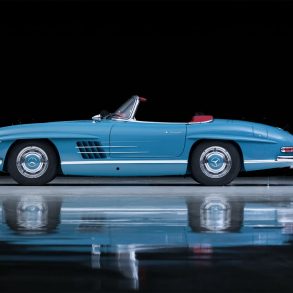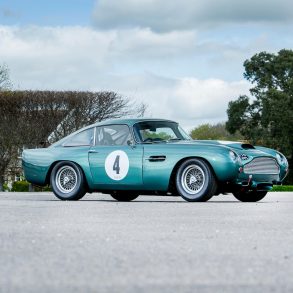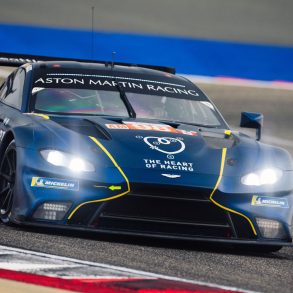
As will be the case in 2009, Aston Martin entered three factory cars in the 1959 race: for Stirling Moss/Jack Fairman, Roy Salvadori/Carroll Shelby and Paul Frère/Maurice Trintignant.
At the time Ferrari was the dominant force in endurance racing, so the Aston Martin team entered the race as underdogs and had to come up with a clever race strategy to defeat the Italian squad. It was decided that the Moss/Fairman car would act as a ‘hare’ to try and force the Ferrari team into an unsustainably quick pace, while the other Aston Martins would follow.
The tactic worked brilliantly, and at 4pm on Sunday 21 June 1959 the Salvadori/Shelby DBR1 crossed the finish line at Le Mans ahead of the sister car of Frère/Trintignant after 24 hours and 4347.9 kilometres of racing. The closest Ferrari, a privateer example in third, was a full 25 laps down.
While the race was a resounding success for Aston Martin and the DBR1, not everything went entirely to plan 50 years ago, as Salvadori remembered. “At the start we quickly got into the hunt and took the lead in the late evening,” he said. “Then we ran into a severe vibration problem. I made a pit stop but the trouble could not be diagnosed so I was sent off again to complete my stint. This cost us a lot of time and we had to make two more pit stops before the fault was found: a large chunk of tread had come off a rear tire but due to the dark and the aerodynamic spats over the rear wheels this could not be seen.”
The number 5 Aston Martin DBR1 pitted in the night to have the offending tire changed, and then it started gaining on the lead Ferrari. “We were faster than the Ferrari and catching it all the time,” added Salvadori. “When the Ferrari retired on Sunday morning, I received a ‘slow’ signal from the pits. But I slowed so much that I had to be speeded up again, as Paul Frère and Maurice Trintignant in the other DBR1 were catching us up!”
A one-two at Le Mans was just one of the high points of a tremendous season for Aston Martin, in which the company also won the World Sportscar Championship.
Aston Martin returns to the top class at Le Mans 50 years later as the underdog once more, but the team is hoping to take the fight to the mighty diesel-powered opposition. These days, there are three drivers to every car as opposed to two in the DBR1’s day, but according to Salvadori a strong working relationship between team mates is still an essential ingredient to success.
“Carroll and I were the ideal partnership,” he said. “We were chosen together because we were the same height and we could both put our left foot between the brake and clutch pedals. We were comfortable together and the team thought that it was a good partnership. At Le Mans back in 1959 we only did one day of practice, or seven laps each.”
The Aston Martin Racing team is preparing for Le Mans this year through participation in the Le Mans Series, which has so far resulted in a win at Barcelona and a podium in Spa. With no Le Mans test day this year, all the teams will have limited running at La Sarthe before embarking on the endurance classic on June 13 at 3pm local time.
Last year’s pole time at Le Mans was 3m18.513; in 1959 the winning DBR1 was set a target lap time of around 4m20s, whereas the fastest lap (set by Moss) was 4m01s. According to the team’s strategy, the Salvadori/Shelby crew concentrated on reliability by keeping their car relatively unstressed and adopting a conservative rev limit.
By the very end of the 1959 race, with a huge margin over the third-placed competitor, the leading Aston Martins could afford to lap at around 4m50s. By contrast, Le Mans these days is more like a series of sprint races punctuated by pit stops – with the race laps not hugely dissimilar to the qualifying laps.
Shelby said: “The DBR1 was a very good handling car but slower down the straight. However, we were definitely superior to the others in terms of handling. And you always felt safe in the car – you always wanted to drive the Aston. I never heard a driver criticise it. At the end, I couldn’t believe we’d won Le Mans because we’d dreamed of it for so long. To win at Le Mans at last was the epitome. Aston Martin was like a personal family and I was very happy for the team.”
The odds are stacked against Aston Martin this year, just as they were in 1959 but Le Mans is a race where miracles can still happen. Just as was the case 50 years ago, winning the Le Mans 24 Hours is not simply a question of having the quickest car or the best-funded team – and that is one of the very few things that has never changed at the Circuit de La Sarthe.
The Aston Martin Racing team is now completing its final preparations for the epic race, hoping for the smallest chance that history might repeat itself. Whatever the outcome, just getting to the end of what is arguably the world’s toughest race is a human and mechanical triumph in itself.
[Source: Aston Martin]









